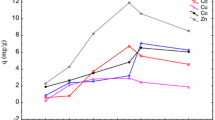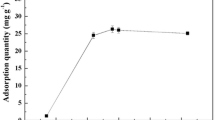Abstract
In this paper, the effects of three coexisting ion systems (Cs, Sr), (Cr, Sr) and (Cs, Cr, Sr) on the adsorption of Sr(II) by irradiated Saccharomyces cerevisiae in solution were investigated. The three systems generally inhibited the adsorption of Sr(II) by yeast. The effects of several environmental factors on yeast adsorption of Sr(II) in coexisting ionic solutions were determined. Three adsorption models, Langmuir, Freundlich and Linear, were used to fit the experimental data. FTIR results showed that the mechanism by which Cs(I) and Cr(III) inhibited the adsorption of Sr(II) was related to the functional groups on the cell wall.






Similar content being viewed by others
References
Hu Q-H, Weng J-Q, Wang J (2010) Sources of anthropogenic radionuclides in the environment: a review. J Environ Radioact 101:426–437. https://doi.org/10.1016/j.jenvrad.2008.08.004
Tanha MR, Hanafiah M, Khalid F, Storai M, Hoeschen C (2019) Current status of radioactive waste management in Afghanistan. J Radioanal Nucl Chem. https://doi.org/10.1007/s10967-019-06974-z
Men W, Deng F, He J, Yu W, Wang F, Li Y, Lin F, Lin J, Lin L, Zhang Y, Yu X (2017) Radioactive impacts on nekton species in the Northwest Pacific and humans more than one year after the Fukushima nuclear accident. Ecotoxicol Environ Saf 144:601–610. https://doi.org/10.1016/j.ecoenv.2017.06.042
Liu H, Wang J (2013) Treatment of radioactive wastewater using direct contact membrane distillation. J Hazard Mater 261C:307–315. https://doi.org/10.1016/j.jhazmat.2013.07.045
Kratochvil D, Volesky B (1998) Advances in the biosorption of heavy metals. Trends Biotechnol 16:291–300
Parekh NR, Poskitt J, Dodd BA, Potter E, Sanchez A (2008) Soil microorganisms determine the sorption of radionuclides within organic soil systems. J Environ Radioact 99:841–852. https://doi.org/10.1016/j.jenvrad.2007.10.017
Sen K, Sinha P, Lahiri S (2008) Immobilization of long-lived radionuclides 152,154Eu by selective bioaccumulation in Saccharomyces cerevisiae from a synthetic mixture of 152,154Eu, 137Cs and 60Co. Biochem Eng J 40:363–367. https://doi.org/10.1016/j.bej.2008.01.005
Zinicovscaia I, Safonov A, Zelenina D, Ershova Y, Boldyrev K (2020) Evaluation of biosorption and bioaccumulation capacity of cyanobacteria Arthrospira (spirulina) platensis for radionuclides. Algal Res 51:102075. https://doi.org/10.1016/j.algal.2020.102075
Hu J, Lv Y, Cui W, Chen W, Li S (2019) Study on treatment of uranium-containing wastewater by biosorption. IOP Conf. Series: Earth and Environ Sci 330:032029. https://doi.org/10.1088/1755-1315/330/3/032029
Kim T, Hong J, Park HM, Lee U, Lee S-Y (2020) Decontamination of low-level contaminated water from radioactive cesium and cobalt using microalgae. J Radioanal Nucl Chem 323:1–6. https://doi.org/10.1007/s10967-019-07008-4
Fomina M, Gadd G (2014) Biosorption: current perspectives on concept, definition and application. Biores Technol. https://doi.org/10.1016/j.biortech.2013.12.102
Niedrée B, Berns A, Vereecken H, Burauel P (2012) Do Chernobyl-like contaminations with (137)Cs and (90)Sr affect the microbial community, the fungal biomass and the composition of soil organic matter in soil? J Environ Radioact 118C:21–29. https://doi.org/10.1016/j.jenvrad.2012.11.007
Bhatt N, Bagla H (2011) Biosorption of radiotoxic 90Sr by green adsorbent: dry cow dung powder. J Radioanal Nucl Chem. https://doi.org/10.1007/s10967-011-1539-3
Shin J, Lee Y-G, Kwak J, Kim S, Lee S-H, Park Y, Lee S-D, Chon K (2021) Adsorption of radioactive strontium by pristine and magnetic biochars derived from spent coffee grounds. J Environ Chem Eng 9:105119. https://doi.org/10.1016/j.jece.2021.105119
Faghihian H, Peyvandi S (2012) Adsorption isotherm for uranyl biosorption by Saccharomyces cerevisiae biomass. J Radioanal Nucl Chem 293:463–468. https://doi.org/10.1007/s10967-012-1814-y
Qiu L, Feng J, Dai Y, Chang S (2017) Biosorption of the strontium ion by irradiated Saccharomyces cerevisiae under culture conditions. J Environ Radioact 172:52–62. https://doi.org/10.1016/j.jenvrad.2017.03.007
Dai S, Yang S, Zhou D (2012) The influence of coexisting ions on adsorption-flotation of Pb2+ in water by gordona amarae. Adv Mater Res 433–440:183–187. https://doi.org/10.4028/www.scientific.net/AMR.433-440.183
Ni B-J, Huang Q-S, Wang C, Ni T-Y, Sun J, Wei W (2018) Competitive adsorption of heavy metals in aqueous solution onto biochar derived from anaerobically digested sludge. Chemosphere. https://doi.org/10.1016/j.chemosphere.2018.12.053
Deng l, Zhu X, Su Y, Su H, Wang X (2008) Biosorption and desorption of Cd2+ from wastewater by dehydrated shreds of Cladophora fascicularis. Chin J Oceanol Limnol 26:45–49. https://doi.org/10.1007/s00343-008-0045-0
Imran M, Anwar K, Akram M, Shah G, Ahmad I, Shah N, Khan ZUH, Rashid M, Akhtar M, Ahmad S, Nawaz M, Schotting R (2019) Biosorption of Pb(II) from contaminated water onto Moringa oleifera biomass: kinetics and equilibrium studies. Int J Phytorem 21:1–13. https://doi.org/10.1080/15226514.2019.1566880
Tan Y, Feng J, Qiu L, Zhao Z, Zhang X, Zhang H (2017) The adsorption of Sr(II) and Cs(I) ions by irradiated Saccharomyces cerevisiae. J Radioanal Nucl Chem. https://doi.org/10.1007/s10967-017-5598-y
Aranda-García E, Chávez-Camarillo G, Cristiani-Urbina E (2020) Effect of Ionic strength and coexisting ions on the biosorption of Divalent nickel by the acorn shell of the oak quercus crassipes Humb. & Bonpl. Processes 8:1229. https://doi.org/10.3390/pr8101229
Huang Y, Li M, Yang Y, Zeng Q, Praburaman L, Hu L, Zhong H, He Z (2020) Sulfobacillus thermosulfidooxidans: an acidophile isolated from acid hot spring for the biosorption of heavy metal ions. Int J Environ Sci Technol. https://doi.org/10.1007/s13762-020-02669-1
Limousin G, Gaudet J-P, Charlet L, Szenknect S, Barthès V, Krimissa M (2007) Sorption isotherms: a review on physical bases, modeling and measurement. Appl Geochem 22:249–275. https://doi.org/10.1016/j.apgeochem.2006.09.010
Ahalya N, Ramachandra T, Kanamadi R (2003) Biosorption of heavy metals. Res J Chem Environ 7:71–79
Zinicovscaia I, Yushin N, Abdusamadzoda D, Grozdov D, Shvetsova M (2020) Efficient removal of metals from synthetic and real galvanic zinc-containing effluents by Brewer’s yeast saccharomyces cerevisiae. Materials 13:3624. https://doi.org/10.3390/ma13163624
Göksungur MY, Uren S, Güvenç U (2005) Biosorption of cadmium and lead ions by ethanol treated waste Baker’s yeast biomass. Biores Technol 96:103–109. https://doi.org/10.1016/j.biortech.2003.04.002
Wang J, Zhuang S (2019) Removal of cesium ions from aqueous solutions using various separation technologies. Rev Environ Sci Bio/Technol 18:231–269
Ngwenya N, Chirwa E (2010) Single and binary component sorption of the fission products Sr2+, Cs+ and Co2+ from aqueous solutions onto sulphate reducing bacteria. Miner Eng 23:463–470. https://doi.org/10.1016/j.mineng.2009.11.006
Blázquez G, Hernáinz F, Calero M, Tenorio G (2009) The effect of pH on the biosorption of Cr (III) and Cr (VI) with olive stone. Chem Eng J 148:473–479. https://doi.org/10.1016/j.cej.2008.09.026
Schmitt J, Flemming H-C (1998) FTIR spectroscopy in microbial and material analysis. Int Biodeterior Biodegrad 41:1–11. https://doi.org/10.1016/S0964-8305(98)80002-4
Qiu L, Feng J, Dai Y, Chang S (2018) Biosorption of strontium ions from simulated high-level liquid waste by living Saccharomyces cerevisiae. Environ Sci Pollut Res. https://doi.org/10.1007/s11356-018-1662-6
Kuppusamy V, Palanivelu K, Manickam V (2006) Biosorption of Copper(II) and Cobalt(II) from Aqueous solution by crab shell particles. Biores Technol 97:1411–1419. https://doi.org/10.1016/j.biortech.2005.07.001
Acknowledgements
This work was supported by National Natural Science Foundation of China (Grant No.11705089) and Natural Science Foundation of Jiangsu Province 331 (SBK201404182).
Author information
Authors and Affiliations
Corresponding author
Additional information
Publisher's Note
Springer Nature remains neutral with regard to jurisdictional claims in published maps and institutional affiliations.
Rights and permissions
About this article
Cite this article
Feng, J., Wang, W., Zhao, X. et al. Effect of Cs(I) and Cr(III) on the adsorption of strontium ion by living irradiated Saccharomyces cerevisiae. J Radioanal Nucl Chem 331, 3093–3105 (2022). https://doi.org/10.1007/s10967-022-08356-4
Received:
Accepted:
Published:
Issue Date:
DOI: https://doi.org/10.1007/s10967-022-08356-4




